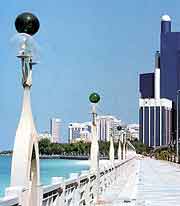Abu Dhabi History Facts and Timeline
(Abu Dhabi, United Arab Emirates, UAE)

The capital of the seven emirates making up the United Arab Emirates, Abu Dhabi has been the home, over millennia, of a number of different cultures.
Nowadays, a large and thoroughly modern metropolis is located here, although the city's long history owes everything to the freshwater springs and lakes dotting the mountainous desert region in the form of oases. It might have remained a Gulf backwater steadily drying up were it not for the discovery of oil.
Early Days
First inhabited during the wetter and more humid regional conditions of the late Stone Age, around 5500 BC, the area around Abu Dhabi was home to herders wintering along the coastline and spending their summers in the pastoral interior. Archaeological evidence shows contacts with the Mesopotamian civilisation. The first permanent settlements in the area began in the Umm an-Nar era, around the third century BC, being spread along the coastline and into the interior.
Zoroastrianism, Christianity and Islam
By 240 AD, the influence of Iran's Sasanian Dynasty brought Nestorian Christianity and Zoroastrianism to the animist Arab tribes. Envoys sent by the Prophet Mohammed arrived some 400 years later, heralding the new religion of Islam.
The region was soon the scene of violent conflict after the death of the Prophet in 632 AD and was subsequently used as a staging point for Islamic armies bent on the conquest of Oman and Iran. By the 10th century, the Buyid dynasty controlled the site of present-day Abu Dhabi and its surroundings.
Arrival of the Portuguese
As the European empires spread their nets across the globe, the Portuguese were the first to arrive in 1498. Chaos ensued, with most of the region falling to the colonists by 1515 and customs outposts milking the city's burgeoning trade with Asia and India. The unwelcome newcomers were to remain until 1633, when British naval superiority introduced a new regime, changing Abu Dhabi's history yet again.
The 19th Century
Since the 17th century, the thorn in the side of British activity in the region had been the Qawasim rebels who, by the mid-19th century, had amassed a fleet of 60 ships to harass British vessels. Finally, a British naval force destroyed the rebel vessels and a General Treaty of Peace with nine local sheikdoms established the Trucial States. In the interior, the Abu Dhabi Sheik, Zayed bin Khalifa Al Nahyan, came to power in 1855, earning himself the title of Zayed the Great. By 1892, Abu Dhabi was a British protectorate.
Oil and the 20th Century
During WWII, the most significant fallout on the emirate was a bloody three-year war with neighbouring Dubai from 1945 to 1948. Then in 1953, the most crucial shift in the history of Abu Dhabi arrived with the discovery of oil. By 1962, the 'black gold' was being exported, quickly transforming the poverty stricken emirate to the richest in the region.
Zayed bin Sultan Al Nahyan, Zayed the Great's grandson, became the ruler of Abu Dhabi and distributed much of the emirate's new-found wealth to other less fortunate sheikhdoms. In 1971, the British left the region and the United Arab Emirates was established, with Abu Dhabi as its capital city. The present-day city is now a triumph of commerce and ultra-modern development.
Although it is Dubai that is most famously known among the Emirate states, Abu Dhabi prudently managed its wealth and had to bail out Dubai during the financial meltdown in 2008. At the time,
Dubai was putting the finishing touches to the Burj tower - the tallest in the world, when it ran out of money.
Abu Dhabi came to the rescue and subsequently the tower was renamed the Burj Khalifa. Abu Dhabi also put itself on the map by hosting an F1 Grand Prix with arguably the most advanced race circuit so far built.
 The capital of the seven emirates making up the United Arab Emirates, Abu Dhabi has been the home, over millennia, of a number of different cultures.
The capital of the seven emirates making up the United Arab Emirates, Abu Dhabi has been the home, over millennia, of a number of different cultures.